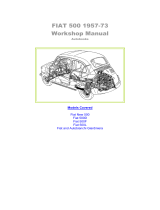
English (GB)
9
3.3.3 Servicing the thrust-handling device from the pump
base
Preparations
1. Disconnect the power supply and remove the power cable.
2. Close the isolating valves, if fitted, to avoid draining the pipe
system.
3. Drain the pump by opening the vent screw (18) and removing
the plugs (25) with o-rings (38).
4. Secure the pump with approved lifting equipment.
5. Loosen the pipe connections to the pump.
6. Loosen the base-plate bolts.
7. Place the pump horizontally with adequate work space around
the pump base (6). Follow the lifting instructions supplied with
the pump.
8. Make sure that the pump cannot move when working on it.
See fig. 14.
Fig. 14 Inserting wedges to avoid that the pump moves when
working on it
Dismantling
1. Loosen and remove bolts (120l) from the pump base (6).
2. Remove the flange (120k) by using two bolts (120l) as
extractors. See fig. 15.
Fig. 15 Extracting the flange
3. Pull out thrust-handling device parts (120g, 120h).
4. Loosen and remove the nut (Note: left-hand thread) (120f)
and washer (120e). Use service tool D to hold the pump shaft
(51) when tightening. See fig. 16
5. Pull out thrust-handling device parts (120a, 120b, 120c,
120d). The parts come out together.
6. To renew the thrust-handling device wear parts, see section
4. Renewing thrust-handling device wear parts.
3.3.4 Assembly
1. Fit thrust-handling device parts (120a, 120b, 120c, 120d).
2. Fit the washer (120e) and nut (120f).
3. Tighten the nut (120f). Use service tool D to hold the pump
shaft (51) when tightening. See fig. 16.
Note: Left-hand thread.
See section 7.1 Torques.
Fig. 16 Holding the pumps shaft (51) with service tool D.
4. Lubricate the stationary ring (120g) on the sides only, and
avoid lubrication of the seal face.
5. Install the lifting plate (120h) in the stationary ring (120g).
6. Install the stationary ring (120g) with lifting plate (120h) in the
flange (120k).
7. Fit the stationary ring (120g) together with the lifting plate
(120h) in the flange (120k).
8. Install the flange (120k) in the pump base (6).
9. Fit and tighten the four screws (120l). See section
7.1 Torques.
4. Renewing thrust-handling device wear parts
Preparations
Renewing the thrust-handling device wear parts requires that the
thrust-handling device (120) has been removed as described in
one of the following sections:
• 3.3.1 Servicing the thrust-handling device by dismantling the
entire pump
• 3.3.3 Servicing the thrust-handling device from the pump
base.
Dismantling
1. Remove the rotating lock ring (120d) from the thrust disc
(120a).
2. Remove the rotating ring (120b) from the thrust disc (120a).
3. Remove the o-ring (120c) from the thrust disc (120a).
4. Remove the o-ring (120i) and the three o-rings (120j) from the
flange (120k).
Assembly
1. Install the o-ring (120i) and the three o-rings (120j) on the
flange (120k).
2. Install the o-ring (120c) in the thrust disc (120a).
3. Install the rotating ring (120b) in the thrust disc (120a).
4. Install the rotating lock ring (120d) in the thrust disc (120a).
4.1 Chamber stack
The chamber stack can be serviced in two ways depending on
which service tool is used for the work:
• Service tool for vice mounting (H1), see section
4.1.1 Servicing the chamber stack in service tool for vice
mounting.
• Service tool for pump base mounting (H2), see section
4.1.2 Servicing the chamber stack in service tool for pump
base mounting.
TM07 1748 2218TM07 1749 2218
TM07 1895 2218






















